Moore College Looking for new Curator
Moore College of Art and Design is looking for a new Senior Curator/Director of the Galleries. Interested applicants should forward their resume, statement of background and qualifications and salary requirements to:
President Fernandez
Moore College of Art and Design
20th Street and The Parkway
Philadelphia, Pa. 19103
Friday, November 24, 2006
Wednesday, November 22, 2006
William J. Marrazzo to Lead Effort to Keep Gross Clinic in Philly
The Philadelphia Museum of Art and the Pennsylvania Academy of the Fine Arts announced today that WHYY President & CEO William J. Marrazzo will "convene and lead a committee of national cultural, civic, and community leaders to broaden the public’s understanding of the social and artistic importance of Thomas Eakins’ 1875 masterpiece, The Gross Clinic, and to ensure it stays in Philadelphia."
According to the news release, "Marrazzo will convene the group, members of which will be announced in the next few days. The members will be national and regional leaders who share the view that The Gross Clinic should remain in Philadelphia, the city in which it was painted."
"I am honored to have been called upon to facilitate the process of generating a dialogue," Marrazzo said. "I feel passionate about the importance of this artwork, and the richness of its history and importance to the city. For me, it is a surrogate of what a mature American city stands for. Projects like this committee represent what it takes for a community to become the next great American city by encouraging civic engagement about a city’s history, and what it means for the present and the future."
WHYY is the leading public broadcasting station in the greater Philadelphia region, and they also offer the Arts & Culture blog called The Sixth Square.
On Thursday, November 30th at 10PM, WHYY will air its documentary from 2001: Thomas Eakins: Scenes From Modern Life.
Lucien Freud Rules in YBAland
German-born British representational painter Lucien Freud has been voted as Britain's favorite artist "in a survey of the UK artistic community."
According to the BBC story:
"He beat the likes of Rembrandt and Van Gogh - who also made the top ten - to become the artists' favourite artist.How else does one say to those YBA's: "You are so yesterday!"
Other modern day giants such as Howard Hodgkin and David Hockney also featured in the poll, carried out by The Great Art Fair.
But so-called Young British Artists such as Tracey Emin, Chris Ofili and Damien Hirst were overlooked.
Hirst, who won the Turner Prize in 1995, garnered only one vote from the 500 artists polled, while Emin and Ofili failed to get a single nod, although 70% of the top ten artists are still alive."
The Top 10 Artists, according to the survey were:
1. Lucien Freud
2. Howard Hodgkin
3. David Hockney
4. JMW Turner
5. Antoni Tapies
6. Rembrandt
7. Jack Vettriano
8. Barbara Rae
9. Frank Auerbach
10. Van Gogh
The real bad boy of British art, the plebian ex-miner and self-taught Scottish painter Jack Vettriano (apparently the world's best selling artist), who is both despised and ignored by the British art establishment while he laughs all the way to the bank and gets great publicity for his work as a result of their dislike of him and his work, made the list once again, this time as the 7th place artist.
Vettriano might as well not exist in the eyes of British museums and the hot curators of the upper crust of the British arts cabal, and yet this somewhat harsh man seems to have touched not only the nerve of the British art establishment, but also the pocketbooks of both art collectors and poster-buyers all over the world, including the US.
I think of Vettriano as the planet's counterbalance to Thomas Kinkaid. They are both hugely popular with the public, but while Kinkaid delivers saccharine scenery ad nauseum, Vettriano delivers an immense range of work that has proven to be both popular and often edgy, as his darkly sexual work testifies.
If an American museum curator had the balls to give the world's best selling artist his first museum show, it would not only be immensely popular, but also create an amazing storm of publicity, arguing and debate as American elitists join forces with their Brit counterparts, while the public votes with their attendance records. It would also plant the opinion that museum are public spaces, not the playground of the rich and snobby.
I can almost smell the gunpowder of debate between those who say that he's nothing but a glorified illustrator, and those who say that he's a sexist pig, and those who say that he's a "fill in the lines" painter, and those who say he's just an ex-miner who has never been educated, and those who pay millions for his paintings at auction, and the Hollywood illuminati, who curiously enough, are some of his biggest defenders and collectors.
But I daydream, as I know not of a single museum director, or curator, who even looks in the direction of where the Vettrianos of this world exist.
The Great Art Fair, the UK's largest art show, will be held at London's Alexandra Palace from 30 November to 3 December, 2006.
Washington City Paper hires new Arts Editor
From: Erik Wemple
Date: November 21, 2006 2:44:30 PM EST
Subject: New Arts Editor
Washington City Paper editorial managers are excited to announce the hiring of Mark Athitakis as our new arts editor. Mark comes to us from a familiar place. The Chicago Reader has employed Mark as an assistant editor since October 2004, and in that time Mark has done everything his people have asked and more. He's been involved in the Reader's Web makeover and is a champion of clean, strong narrative copy. The guy came in here with barely a couple day's notice and produced an outstanding critique of our arts coverage and showed a command of all that you must know to be an arts editor in a town like D.C. He'll be starting shortly after the New Year.
Katie Tuss on Mark Cameron Boyd at the Katzen
Logocentric Playground at the Katzen
By Katie Tuss
Washington area based artist Mark Cameron Boyd has been using his own deconstructed, re-contextualized sentences as the subject of his current body of work since 2003. Boyd’s thoughtful, challenging pieces utilize “text as a language for painting” while questioning the accepted systems of meaning and conventional constructs of art and communication.
In the installation Logocentric Playground, currently on view at the Katzen Arts Center, Boyd encourages visitors to engage him in an unspoken conversation using any of the three blackboards in the first floor gallery space. The boards display handwritten, original text by Boyd in red and white chalk.
Employing painter’s tape in his signature erasure method, Boyd obscures either the top or bottom of the upper case letters in each sentence. Crisp black lines alternate horizontally between truncated peaks of the letter “A” and severed curves of the letter “P.” Bisected red words meet bisected white letters, one on top of the other, altering the artist’s initial transcription.
A piece of chalk, but no eraser, can be found underneath each blackboard. Seemingly without hesitation Katzen Center visitors have picked up the artist’s discourse.
Viewers have interpreted the inconclusive text by completing interrupted letters and adding words and original symbols above, on top of, and around Boyd’s phrases.
Despite the interactive component of the piece, it doesn’t require any contribution to the installation to appreciate the original enigmatic markings and the development of Boyd’s relationship with the viewer and the piece over time.
Boyd plans on returning to Logocentric Playground at least once a week to remove, restore, and respond to his conversation partners. The installation's progress can be tracked on the artist’s Web site.
Logocentric Playground is on view through December 15, 2006.
Disclaimer: I (Lenny not Katie), in the past, have curated Boyd's work into several shows focused on "text."
Tuesday, November 21, 2006
City Hall Art Collection Walkthrough
A few days ago I had the opportunity to walk through the new Washington, DC City Hall Art Collection at the Wilson Building.
Together with Jonathan Binstock and Sarah Newman (both curators at the Corcoran), and Kristen Hileman and Anne Ellegood (both curators at the Hirshhorn), and Kim Ward (Executive Director of the WPA/C), we were given a personal tour of the collection by its curator, Sondra Arkin.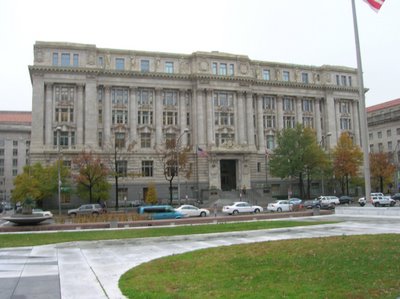
I had never been to the Wilson Building before, and I must admit that I have probably walked or driven by it a dozen times in the past without being aware that this is the place where the District's business as a city take place. The building is very beautiful and recently renovated, and the insides incorporate and marry the building original neo-classical appeal with a modern sense of stainless steel and minimalist design in places.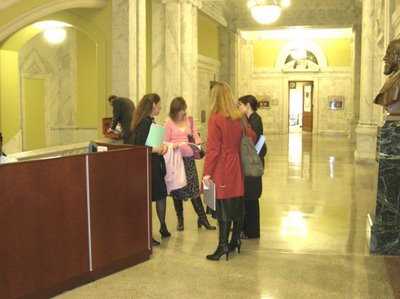
After passing through the excellent security check-in at the front entrance (ID required), Sondra gave us all a copy of the superb catalog that she was able to create in about six weeks.
The Hirshhorn curators and I were astonished that Arkin was able to pull off such a quality catalog, plus do a huge number of studio visits, plus curate the exhibition, and organize the framing, in a handful of weeks.
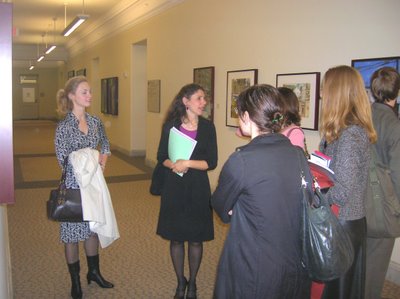
Arkin begins tour
I am always complaining that DC area museum curators seldom pay attention to district artists, and I think that the major contribution that this collection offers is a central point for them and visitors to see the vast array of talent that our capital area has to offer.
One exception and a DC area artist who needs little introduction to curators is the ubiquitous and hard-working Maggie Michael, and one of the first works that we were taken to was "Phantom," a large painting by Michael on the first floor.
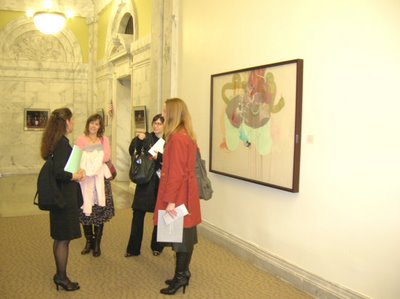
I must admit that as we approached the painting I thought that it was a piece by Trawick Prize winner Jiha Moon and said so, which brought some quizzical looks directed at me from the fair Anne Ellegood. But I stuck to my guns and noted that the painting seems to borrow heavily from Moon's visual ideas, and the "center" of it appears to be a Jiha Moon on top of a Maggie Michael painting.
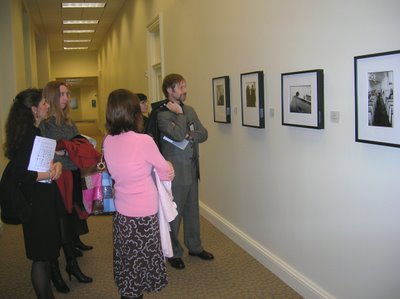
Curators Looking at Prescott Moore Lassman's photographs
Another artist whose work caught some good detailed attention were the photographs by Prescott Moore Lassman, which when associated with the story behind them (the subject were the people in one of the first integrated churches in the nation), seemed to merit some extra time from them. Prescott's skills with the camera to capture the essence and depth of a moment, while making the image burst with attention-grabbing intrigue, is what makes his work special.
The Hirshhorn curators both seemed to like "In Red," a beautiful canvas of Tom Green's invented symbols, which also appealed to me based on my interest in "text" in art. As such I had to take the opportunity to taken them to Mark Cameron Boyd's "No Way to Convey," and explain Mark's fascinating process to create art out of textual references.
Somewhere along the tour, we discovered Judy Jashinsky's 1980s vintage portrait of Corcoran photography curator Philip Brookman, and Binstock, Ward and Newman had a bit of good fun enjoying their fellow curator's portrait. "He still has that watch!" someone said.
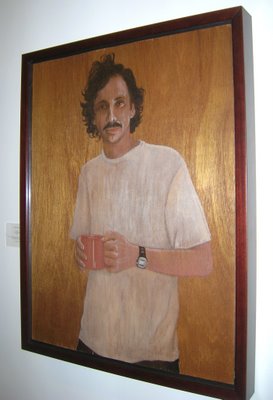
Philip Brookman by Judy Jashinsky

Jonathan Binstock records the Brookman
The representational holdings in the collection, as usual, brought out interesting stories about them, and the reaction to them from the building's occupants. The ability of a representational work to clearly convey an idea or suggestion immediately makes its selection for a public art display a very difficult process - at least in the United States.
One artist who must have been very hard for Arkin (no pun intended) to select is the talented Joe Shannon, who regularly appeals in his own paintings, not only nude, but also often sporting a massive erection. But not the piece in this collection, "Two Poets with Champion," in which Joe does sneak in a shirtless male.
The physical attributes of the space itself, and the occupants themselves, also played an important role in Arkin's selection and placement process, as some of the city fathers and mothers "own" certain halls (where their offices are) and were part of the process for what "hung" there.
Tucked away in the furthest corner of one such hall is Michal Hunter's "The Fountain," a overtly sensual 1981 painting by one of Washington's top realists. There is no nudity in this work of two women enjoying the sun and refreshing themselves in a public fountain. But there's plenty of implied sensuality and Eros in this work, which may be the sexiest public art piece in the nation's capital.
The DC glass gods are also well represented in this collection (although so far ignored by DC area museums and curators, while at the same time being picked up by other American museums), with two mixed media pieces by Tim Tate and Michael Janis.
Photography is an important part in the collection, with the usual suspects represented by a mix of well-known work or new images. Works by top photographers such as William Christenberry, Maxwell MacKenzie, and Chan Chao are complemented by newly emerging camerartists such as Alexandra Silverthorne, Prescott Moore Lassman, Holly Foss and others.
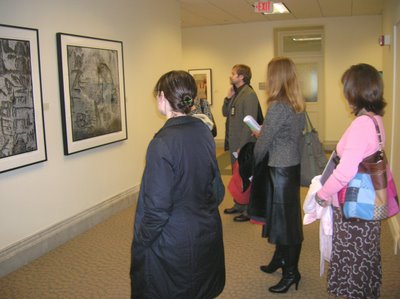
Curators looking at Maxwell MacKenzie's new work
The collection is also well stocked with some of the District's top names from the "old school", such as Gene Davis, Jacob Kainen and Felrath Hines, while active well-known names such as John Winslow, Sam Gilliam, Michael Clark, Robin Rose, James Huckenpahler and others are also augmented by very good works by Pat Goslee, Jiha Moon, Lisa Montag Brotman, Anil Revri, Michele Banks and Andrew Wodzianski.
Not all is perfect. While looking at Kainen's two rather forgettable etchings in the collection (Blue Cocoon and Dr. Mabuse), I made the comment that I wasn't a big Jacob Kainen fan, which brought out an alarmed look and immediate response from Jonathan Binstock. We discussed the issue, and while I certainly admire Kainen's amazing work ethic and his persistence in making an art footprint in the District (which he did), I have never been particularly attracted to his work, although I will allow that a DC collection without a Kainen is missing a key component, so I am glad that he's represented here.
Talking about "missing," there are some notable missing names from this collection, such as Maggie Michael's talented husband (Dan Steinhilber), some Color School guys like Morris Louis (completely unaffordable at this point, so a donation would be nice), Margarida Kendall (same issue), Annie Truitt (same problem), Manon Cleary, Erik Sandberg, Molly Springfield, Kelly Towles, Mark Jenkins, Colby Caldwell, Kathryn Cornelius, etc.
Finally, I've been getting some emails complaining about the scarcity of sculpture in the collection. This is always an issue in "indoor" public art, as a large range of sculpture does not adapt well to being exposed and inside public buildings. But I think that Arkin did an excellent job of acquiring a good set of three dimensional works, such as the previously mentioned works by Tim Tate and Michael Janis, plus excellent pieces by Margaret Boozer, Marie Ringwald, Jae Ko, Andrea Haffner and F.L. Wall. Well-known sculptor Yuriko Yamaguchi is represented by an interesting litho.
I think that I know district area artists as well as anybody, and yet even I "discovered" some new artists who have excellent work in this collection. One such artist is printmaker Alexandra Huttinger, whose series of small linoleum prints not only capture a visual record of people, but also push the limits of that difficult medium. Brenda Hoffman's photographs also caught my attention (and that of a couple of the curators).
In spite of Sondra Arkin's spectacular effort, there are still plenty of empty walls left in this building, and it is my hope that the District of Columbia Commission on the Arts and Humanities will expand on this $400,000 investment and continue, on a regular basis, to grow the collection, and to add to it on a yearly basis, so as to truly make it into an almost Washington Art Museum.
The Gross Clinic"The Board of Trustees of Thomas Jefferson University has authorized the sale of Thomas Eakins' painting The Gross Clinic (1875) to the National Gallery of Art (Washington, D.C.) and the Crystal Bridges Museum of American Art (Bentonville, Arkansas). Through a private sale arranged by Christie's in New York, the Board has accepted an offer of $68 million for the painting, the highest price ever paid for a work by the artist and, by far, a record for any work of art created in the United States before World War II. Local art museums and governmental institutions have the opportunity to match the offer with a preemptive bid within 45 days."
And in order to "match the offer," The Philadelphia Museum of Art, the Pennsylvania Academy of the Fine Arts, and various public and private Philly institutions, city officials, and civic leaders are joining forces in an effort to raise $68 million to keep Thomas Eakins’ 1875 masterpiece, The Gross Clinic, in Philadelphia.
Philadelphia Mayor John F. Street gave his endorsement of the effort. He said: "I am encouraged by the strong voices of support within our community for keeping this magnificent painting in Philadelphia. Our city has an extraordinary fabric of arts and culture which makes us a magnet for visitors from all across the nation and around the world, and provides a great quality of life for all of our citizens. Retaining The Gross Clinic will underscore that reality and ensure a place in the heart of our city for this treasured painting."
The public can help by giving to the Fund for Eakins’ Masterpiece, established to raise the money to match the sale price of $68 million. Make a tax deductible contribution online here, or mail a check made payable to Fund for Eakins’ Masterpiece and send it to:
Fund for Eakins’ Masterpiece
c/o Philadelphia Museum of Art
P.O. Box 7646
Philadelphia, PA 19101-7646
The Fund for Eakins’ Masterpiece HOTLINE is reachable by calling 215-684-7762.
Monday, November 20, 2006
The Baileyfication of Washingtonian
Washingtonian magazine comments on the Downie memo that I published here a while back.
And am I the only one that notices that the tone and writing style of this Harry Jaffe article reads like a Bailey?
And as if we didn't already know this was coming: according to the article, "Style editors have already put out a memo this week ordering major cuts in length. For instance, 60-inch stories should be 40 to 45 inches."
If you don't get it, you don't get it.
Projects Gallery
Adding to my list of Mid Atlantic area art galleries and private dealers heading to Miami next month, Philadelphia's Projects Gallery will be at Bridge Art Fair Miami at the Catalina Hotel & Beach Club - Room 212.
They will be featuring artists Steve Cope, Peter Gourfain, Tom Judd, Frank Hyder, Florence Putterman and others.
Projects Gallery also has "surprising and unusual works by big-name artists" in an exhibition titled "little secrets." First Friday reception on Friday, December 1st, 2006 5 - 9 PM and running through December 1st - 22nd, 2006. The exhibition includes works by Chuck Close, Sidney Goodman, Peter Gourfain, James Havard and James McGarrell.
The Rise of Gaming
Interesting editorial in the WaPo today.
"The Rise of Gaming - The 21st century's oil painting?" offers the suggestion that "Social observers are beginning to deem video game design an emerging art form, especially as companies ratchet up production values."
Fair enough, but the 21st century still has oil painting... and acrylic painting, and encaustic painting, and spray painting, etc.
Nowhere in the editorial is the practice of painting mentioned. But the fact that it is in the subtitle greatly indicates what the WaPo's management thinks about the function of the fine arts in our society today.
And I keep hearing through the grapevine that the coming changes in the WaPo, including the fact that "work is underway to create a new Sunday Style and Arts section," will actually mean less fine arts coverage by the newspaper.
This is not good.
Sunday, November 19, 2006
Caroline Altmann Story
"Reflecting on My Retrospective" by Caroline Altmann is presented below, and it is without a doubt one of the most interesting introductions (by the artist) to the exhibition space's "official" news releases that I've read in a long time.
Caroline Altmann on Becoming An ArtistWhere: Poltrona Frau Washington 1010 Wisconsin Avenue, NW in Georgetown
What is a portfolio manager doing twisting, turning and shaking around cacti, hydrangeas, and hostas? Five years ago, I left Wall Street to raise my children near their grandparents. (They live in Mount Vernon.) I then sat down to meditate, something I was too busy to do while managing $2 billion in assets for Bankers Trust. Every time I sat down, complete art ideas rushed into my mind. It was as if a door to a creative bank vault had burst opened. So, out went the notion of starting a new career at the World Bank and in came the idea of becoming an artist.
This change was in fact a bridge to an earlier phase in my life. My parents were collectors of baroque sculpture. Art was the fabric of my Brazilian birthplace’s culture. A family move to England brought new sensibilities – rawness of punk aesthetics and classical sophistication of European capitals. Museum outings to the Prado, for example, were highlights. Then at Tufts University, late nights increasingly devoted to the darkroom rather than early mornings to US diplomatic history precipitated a change in majors -- from international relations to art history. I studied photography at the joint program with the School of the Museum of Fine Arts in Boston.
Thereafter, I found work in local galleries and interned at the museum. But that didn’t bring me enough satisfaction. I continued to photograph but I wanted to collect. Gallery pay was low during those recession years. So getting an MBA seemed a good idea. But it came at a cost. No more time for making art. And, after living in Japan with no possessions, I lost the urge to collect. Fifteen exciting years were marked by the Tokyo Stock market crash, the 90’s Bull Market, a new fabulous husband. With a 9 month-old baby in my belly, I move away from New York to Virginia where grandparents and a new career awaited. After we were settled, I attempted to leap from managing money to making art.
That change was as overwhelming as blank canvas can be. How do I become an artist? Do I deserve to become an artist? Shouldn’t I have known from an early age that this was the only thing I could do? And then, struggled for years? Artistic myths, hmm. But the voice of the budding artist tentatively suggested, “Roy Lichtenstein only turned to fine arts in his late thirties. And, how about Philip Johnson? He only got his architecture degree later on in life.”
I called Ingo Günther in New York. He is a successful international artist and dear friend. "Ingo, I am going to be an artist. Do not discourage me. Tell me how to do it." I blurted. I ordered the book, "The Artist’s Way," joined a couple of art groups, Secondsight, for women photographers and WCA-DC, recommended by a neighbor for women artists. The closest I have come before to joining groups was adding my name to business directories. And then I got lucky.
The woman who founded Secondsight, Catriona Fraser, also sponsored a seminar, "Success As An Artist." The all day event was a neatly organized agenda of all the lessons she and Lenny Campello (of "dcartews" blog fame) learnt over 20 years, plus a fabulous packet of resources. I started sculpture and then dove back into photography – a passion at college. Then I got lucky again.
Late for a lunch in Georgetown, stopping too quickly at a stop sign, a police officer gave me a moving violation. To boot, my lunch date called, postponing by an hour. I felt so foolish and mad at myself that I was determined to make something good of it. So I went into several high-end furniture showrooms with perfect walls to sell my multi-piece compositions. Two places said, “Yes!” One space is so large that I will have over 50 pieces in it. A showing of that size is unique. So after a few years of struggling, I’ve got my first solo show and it’s a retrospective!
What is an ex-portfolio manager doing twisting, turning and shaking around cacti, hydrangeas, and hostas? Come see the work – it is a unique portrait of nature moved, turned and swayed. There are also examples of my studio work where movement comes from posed dried flowers. The opening is on December 7th at Poltrona Frau at 1010 Wisconsin Avenue at 6:00PM. Please rsvp to info@frauwashington.com or call 202 333-1166. My work can also be seen on www.altmann.us
When: From December 8, 2006 to March 8, 2007
Contact: 202 333 1166 or info@frauwashington.com
Artist: Caroline Altmann
Exhibit Title: “Undercurrents of Pure Joy”
Saturday, November 18, 2006
Hirshhorn Museum Acquires 24 Contemporary Works of Art
From the Hirshhorn news release:
The Hirshhorn Museum has acquired 24 new works of art—many of which complement current holdings and reinforce the Hirshhorn's commitment to collecting key artists' work in depth, as the Museum’s founder, Joseph H. Hirshhorn did. Several of the works were included in recent exhibitions at the museum. Most notable among these acquisitions are 13 photographs from the "Seascape" series by Japanese artist Hiroshi Sugimoto, which were installed in one long dramatically lit gallery last winter as part of the acclaimed "Hiroshi Sugimoto" exhibition. These large-format photographs are the gift of The Glenstone Foundation, founded by Mitchell P. Rales. One photograph, "Caribbean Sea, Jamaica," (1980) was given in honor of Kerry Brougher, chief curator and director of art and programs at the Hirshhorn, who organized the Sugimoto exhibition.The Glenstone Foundation, was established by DC area ubercollector Mitchell P. Rales, who also happens to be on the Hirshhorn’s board.
"We are immensely grateful to The Glenstone Foundation for this generous gift. These works will be a highlight of the Hirshhorn's growing contemporary collection—and because Glenstone has given the entire seascape room from the exhibition, we will have the opportunity in the future to recreate the original installation in addition to presenting the photographs in other contexts," Brougher said.
Two of the new acquisitions are purchases from "The Uncertainty of Objects and Ideas: Recent Sculpture," the exhibition currently on view at the Hirshhorn: Rachel Harrison's "Pretty Discreet" (2004) and Isa Genzken's "Untitled" (2006). Works by Jim Lambie, whose recent site-specific "Directions" project transformed the museum's lobby into a lively, interactive space, were also acquired: "Male Stripper" (2003), a black-and-white striped floor installation, and "Boobaliscious" (2004), a sculpture made from glitter, PVC pipes and sequined tube tops.
A brightly painted and sculpted canvas by Washington artist Sam Gilliam, "Ruby Light" (1972), a museum purchase and partial gift of the artist and Marsha Mateyka, and a stacked and cut paper installation by Uruguayan artist Marco Maggi, "Hotbed (DC)" (2006), the gift of the artist, will increase the Hirshhorn's holdings of these artists, giving visitors a deeper understanding of the breadth and scope of their artistic production.
Several purchases by the museum bring artists into the collection for the first time, including three photographic works by Christopher Williams, a triptych by Troy Brauntuch and a framed collage by Al Hansen.
Friday, November 17, 2006
Heading to Miami Beach
Many Mid Atlantic area art galleries and dealers are heading to the December Floridian arts extravaganza centered around Art Basel Miami Beach.
Here are some; email me if you want a shout out here for your gallery's booth.
Philly's Pentimenti Gallery will be at Bridge Art Fair Miami, Booth #206. Also from Philly, Ashley Gallery will be there (and in SCOPE).
Potomac, Maryland's hard-working (and world travelling) dealer Rody Douzoglou will be at SCOPE Miami, where you will also find Richmond's ADA Gallery, Philly's Ashley Gallery, the District's Curator's Office, as well as Conner Contemporary's new "gogo art projects." Scope Miami seems to be overloaded with NYC and German galleries.
Update: Conner Contemporary will also be at Pulse Miami
Artist Websites
Artists are always emailing me and asking me at various forums questions about website design for their art.
The KISS rule really applies here: Keep It Simple Stupid.
Avoid cute little buttons; have your contact info on every page; keep the site clean and minimalist and professional; and offer (not force) info. Above all, avoid cute little musical backgrounds and annoying flash loaders.
In the 21st century, the digital footprint is as important as a telephone and a business card, so everyone who is serious about their artwork should and must have an online presence.
DC area artist Rosetta DeBerardinis, a proud Vassar alumni (I discovered that in her website), has a new website and it is a perfect example of good and easy design that offers all the visual info needed for an artist website.
According to the website itself, it was designed by www.websiteforartists.com, so consider this an unrequested plug for them.
Visit her new website here.
Notes, Icons, and Symbols
Remember the Rockville Arts Place (RAP)? Well, they are now called VisArts and opening with a reception from 3 to 5 on Sunday, November 19 (the exhibit runs through December 16, 2006), they have what sounds like a very interesting show.
The exibit is "Notes, Icons, and Symbols," and as his contribution to the exibit, the very talented John Borstel will be presenting a new installation titled "Closet Opera" which has been described as a "grand romantic and Fairy opera in 40 fragments."
According to John, "the piece features a series of photo-based images in which the artist himself portrays nine characters, altering his appearance through the use of simple props, accessories and a single costume manipulated into various distinctive configurations."
Notes, Icons, and Symbols also features work by Sharon Murray and Carien Quiroga. A panel discussion with the artists, titled “A Question of Identity” takes place on Sunday December 3 at 3pm.
VisArts is located at 9300 Gaither Road, Gaithersburg, MD. Further information is available at www.visartscenter.org or by calling 301-869-8623.
City Hall Collection in the WaPo again
The WaPo's District Extra section has a nice review of the new City Hall Art Collection curated by Sondra Arkin. So far the collection is getting very positive reviews from all sort of unexpected sources.
Read the piece by Paul Schwartzman here.
Recently I walked the collection with Kristen Hileman and Anne Ellegood (curators from the Hirshhorn) and Dr. Jonathan Binstock and Sarah Newman (curators from the Corcoran), as we were taken around by Sondra.
I will offer my impressions of the visit soon.
A Phenomenon of Nature
Curated by the vastly talented Dr. Claudia Rousseau, A Phenomenon of Nature, opens tomorrow (Nov. 18) with a reception from 5 - 7 pm at the unexpectedly huge and gorgeous BlackRock Center for the Arts in Germantown, Maryland.
The exhibition includes work by Syl Mathis, Michael Janis and Tim Tate, and also features a retrospective of photographs by Mark Evan Thomas.
If you haven't seen this massive arts venue yet, this is a perfect opportunity for a Saturday drive. The BlackRock Center for the Arts is at 12901 Town Commons Drive, Germantown, MD 20874, Phone: 301.528.2260
Thursday, November 16, 2006
Girl with RoachesRemember this post where I discussed gallery-goers' reactions to Scott Lassman's photograph "Girl with Roaches"?
"Girl with Roaches," has been published in Black & White Magazine, one of the premier national magazines dedicated to black and white photography.
The photograph was selected as part of the magazine's 2007 Single Image Contest Awards and is published in their B&W Special Issue, which is available in bookstores and newsstands now.
Congrats to Lassman and it's on page 167. Check it out!
